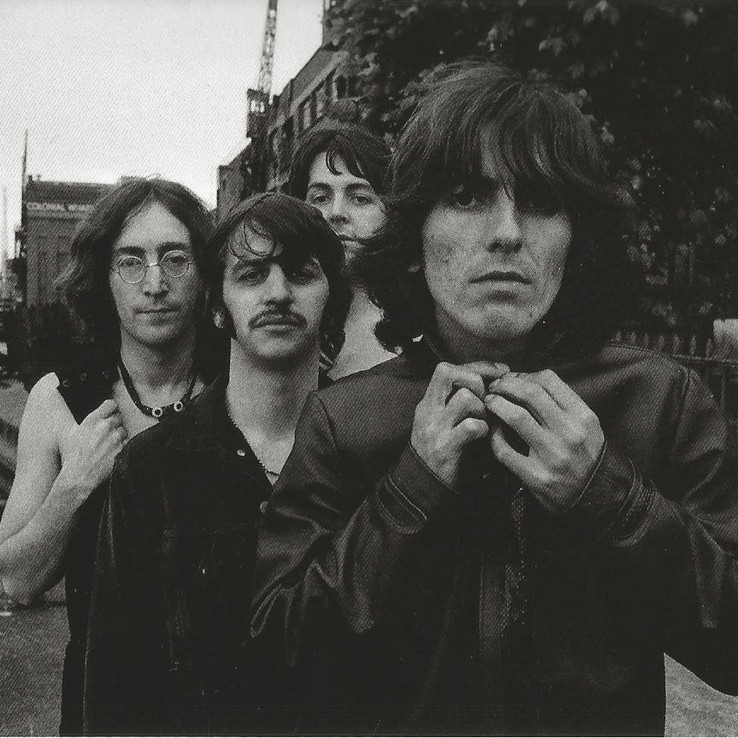The Beatles’ “Hey Jude” is more than just a song; it’s a cultural touchstone, a singalong staple, and a testament to the band’s songwriting genius. Released in 1968, amidst a backdrop of personal turmoil and global change, “Hey Jude” quickly ascended to become one of the most iconic songs in music history. This article delves into the rich history of the Hey Jude Song, exploring its origins, creation, impact, and enduring legacy.
 The Beatles in 1968
The Beatles in 1968
The Genesis of “Hey Jude”: From Sorrow to Solace
The story of Hey Jude song begins in a moment of personal crisis. In 1968, John Lennon’s marriage to Cynthia Powell was unraveling due to his burgeoning relationship with Yoko Ono. Witnessing the emotional distress of Julian Lennon, John and Cynthia’s young son, Paul McCartney felt compelled to offer comfort.
Driving out to visit Cynthia and Julian, McCartney began composing a song in his head. Initially titled “Hey Jules,” the lyrics were a direct address to Julian, intended to console him during his parents’ separation. “Hey Jules, don’t make it bad,” McCartney sang, “take a sad song and make it better.” The name “Jules” soon morphed into “Jude,” which McCartney felt sounded more resonant.
This compassionate impulse evolved into Hey Jude song, a ballad that transcended its personal origins to become a universal anthem of hope and resilience. While initially inspired by Julian’s sadness, the song’s message of finding positivity in adversity resonated with a far wider audience.
Crafting a Masterpiece: Composition and Recording of Hey Jude
Hey Jude song is notable for its unconventional structure and length, especially for a single released in the late 1960s. Breaking away from typical pop song conventions, “Hey Jude” extends beyond seven minutes, with a significant portion dedicated to an extended coda featuring the now-famous “na-na-na” vocalizations.
The song’s composition showcases McCartney’s melodic gifts and songwriting prowess. The verses offer comforting advice, while the chorus builds in emotional intensity, culminating in the cathartic release of the outro. Lennon himself recognized the song’s brilliance, famously declaring it “the best of McCartney’s songs.”
Recording sessions for Hey Jude song were not without their tensions, a reflection of the growing strains within the Beatles. Early sessions took place at Abbey Road Studios, but the band later moved to Trident Studios, seeking access to its advanced eight-track recording technology.
Geoff Emerick, the Beatles’ long-time recording engineer, ultimately quit during these sessions, citing the increasing friction within the band. Ken Scott stepped in to replace him, and the recording process continued, albeit under a cloud of internal conflict.
One famous anecdote from the recording sessions involves Ringo Starr. Reportedly, Starr had left for a bathroom break just as a take began. He rushed back to his drum kit and managed to join in perfectly, without missing a beat. This story highlights the Beatles’ musical telepathy and Starr’s renowned drumming skills.
The extended coda of Hey Jude song was a key element in its impact. Initially conceived as a shorter section, it evolved into a lengthy, almost mantra-like repetition of “na-na-na,” driven by McCartney’s piano and vocals, and eventually joined by the orchestra and backing vocals. This section, initially questioned by George Martin for its length, became a defining characteristic of the song and a powerful audience engagement tool in live performances.
George Martin’s orchestral arrangement further elevated Hey Jude song. Initially hesitant about the song’s length and repetitive outro, Martin recognized the potential to enhance the coda with orchestral instrumentation. His arrangement added depth and grandeur to the song’s climax, transforming it into a truly epic musical experience.
Release and Reception: Hey Jude’s Global Domination
Released as a single in August 1968, Hey Jude song was an immediate and overwhelming global phenomenon. It topped charts in 17 countries, including a remarkable nine-week reign at number one in the United States – a record at the time. In both the US and the UK, it became the biggest-selling single of 1968, cementing its status as a cultural phenomenon.
The song’s length, initially a concern for radio play, proved to be no obstacle to its success. Radio stations, recognizing the Beatles’ immense popularity and the song’s undeniable appeal, embraced Hey Jude song, playing it in its entirety despite its extended runtime.
However, the promotional efforts for Hey Jude song were not without controversy. In a misguided attempt at street art, McCartney and his then-girlfriend painted “Hey Jude” and “Revolution” on the windows of the Beatles’ defunct Apple Boutique. Unbeknownst to them, “Jude” is German for “Jew,” and the display inadvertently evoked painful memories of Nazi-era anti-Semitic graffiti, causing offense and requiring a swift apology from McCartney.
Despite this unfortunate incident, the overwhelming public reaction to Hey Jude song was one of adoration and acclaim. Its message of hope and resilience resonated deeply during a turbulent year marked by political unrest and social change.
The Enduring Legacy of Hey Jude Song
Decades after its release, Hey Jude song remains a beloved and universally recognized classic. Its enduring appeal stems from its powerful melody, comforting lyrics, and cathartic singalong coda. It is a song that transcends generations, continuing to inspire and uplift listeners around the world.
Hey Jude song has been interpreted in various ways, reflecting its multifaceted nature. While initially inspired by Julian Lennon’s personal sadness, it has been seen as a broader message of hope in the face of adversity, a love song, and even a song about the changing dynamics within the Beatles themselves, with McCartney offering Lennon a gentle push towards his new life with Yoko Ono.
Lennon himself often cited Hey Jude song as one of his favorite McCartney compositions, interpreting its message as a blessing for his departure from the Beatles and his new relationship. This highlights the complex and intertwined personal and creative relationships within the band.
The song’s impact extends beyond popular culture. Hey Jude song has been used in countless films, television shows, and commercials, further solidifying its place in the collective consciousness. Its “na-na-na” coda has become instantly recognizable and universally singable, uniting audiences across language and cultural barriers.
In conclusion, Hey Jude song is a timeless masterpiece that embodies the Beatles’ songwriting genius and their ability to connect with listeners on a deeply emotional level. From its poignant origins in personal sorrow to its global reign as an anthem of hope, Hey Jude song continues to captivate and inspire, ensuring its legacy for generations to come. It stands as a testament to the power of music to heal, uplift, and unite.
Further Reading & Resources:
- The Complete Beatles Chronicle by Mark Lewisohn
- All The Songs: The Stories Behind Every Beatles Release by Jean-Michel Guesdon
- And The Band Begins To Play: The Definitive Guide To The Songs of The Beatles by Steve Lambley
- Revolution in the Head by Ian MacDonald
- The Beatles Anthology
- Many Years From Now by Barry Miles
- Here, There, and Everywhere: My Life Recording the Music of the Beatles by Geoff Emerick and Howard Massey
- The Beatles: The Stories Behind the Songs 1967-1970 by Steve Turner
This article is inspired by Episode 171 of the “A History of Rock Music in 500 Songs” podcast.

